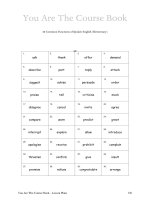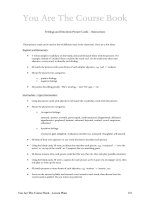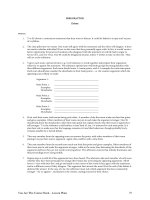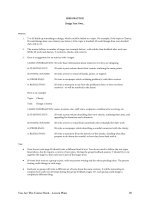yatcb lesson plans team building games
Bạn đang xem bản rút gọn của tài liệu. Xem và tải ngay bản đầy đủ của tài liệu tại đây (72.34 KB, 5 trang )
FREE PRACTICE
Team Building Games
Note: this is a short collection of games to give an example of the kind of thing that you could use during free
practice sessions and warmers. T should add their own games and ask SS to suggest their favourites too.
Random Way of Choosing Teams:
LISTENING
T asks SS to line up in order of their... height, age, shoe size, first initial, second initial of their street/pet/sister’s
name/favourite TV programme, etc. Then T gives each person a number, from left to right, or right to left, e.g. 1,
2, 3, 4, 1, 2, 3, 4 – if 4 teams are required. Then all the 1’s work together, as do all the 2’s, 3’s, and 4’s.
Creative Vocabulary:
ACTION, CREATIVITY
SS work in teams to create the best model of a vocabulary word out of:
•
•
•
modelling clay
balloons
maize snacks / breakfast cereal
•
•
•
recyclable material
old newspapers / magazines
other handy material
Wrong Stress, Wrong Sounds
PRONUNCIATION, LISTENING
SS read a sentence aloud and stress all the wrong syllables, then read it correctly. Or, SS read a sentence aloud and
have the right stressed syllables, but the wrong vowel sounds on the stresses. How easy is it to understand? Use this
activity to demonstrate the vital importance of SS having both the correct stressed syllable in a word and the correct
vowel sound on that syllable.
Drama:
CREATIVITY, VOCABULARY, GRAMMAR
SS create and present a performance piece based on the topic and/or vocabulary that they have been studying. This
could be in any of the following forms – or something else:
•
•
•
Role play
Dialogue
Make a musical
•
•
•
Puppet work
Mime
Dance
...and so on.
You Are The Course Book – Lesson Plans
99
Multiple Choice Quiz:
LISTENING, ACTION
A quiz where there are four possible answers – a, b, c, and d. SS have to stand in the middle of the room, then run to
a corner – marked a, b, c, or d – to show their answer. If they are wrong, they leave the game and the remaining SS
continue without them, until there is one winner.
Simon Says:
LISTENING
A party game that works well with English students as a way of practising listening to and understanding
commands. Say a number of simple commands, such as, “Put your hands on your head”, “Stand on one leg” or
“Start humming”, and the students have to do what you say – but only if you have prefaced the command with
“Simon says...” If you do not say “Simon says...” and the student follows the command, that student is out, and the
game resumes until there is a winner. This is a fun game that SS can lead too.
Party Invitations:
LISTENING
The whole class sits in a circle. Tell them that it is your birthday next week and that you’re planning a birthday
party. They are all invited... but on one condition. They must bring you a present, and it must be something that
you really want. Each student in turn tells you what he or she will bring to give you on your birthday. You will tell
them either that they can come, or that they are not invited. This depends on what they offer to bring you. The
item they are going to bring must begin with the same letter as your first name. If it does, they can come; if it does
not, they cannot. For example, if your name is Lucy and they offer to bring “a lemon” as a present, they will be
welcome. If they offer to bring “a bottle of wine”, they will be given short shrift! This game is hilarious, as some
students will twig onto your ‘unspoken rule’ early on, while some will not get it at all, however obvious you make
it!
Whispering Trees:
LISTENING
Get the students standing in a line. Stand at one end and whisper a short phrase or sentence in the ear of the student
next to you. For example, you could say, “My dad once met Brad Pitt in a bus queue in Dover.” Each student
repeats the phrase to their neighbour until you get to the end of the line, when the last student tells the class the
sentence they heard, and you can reveal what the original sentence was. A good game for practising listening skills.
What’s Going On...?
LISTENING
Probably better for an intermediate or advanced class, this one. Prepare twenty questions, based on what is
happening in the news (be it local, national or world news). You could include spelling questions too, and questions
about different members of the class, for example, “Which country does Louisa come from?” Split the class into two
teams and you are ready to play. Give five points for a correct answer and bonus points at your discretion for
any extra information that the students give in their answers. If the first team does not know the answer, hand it
over to a different team for a bonus point.
You Are The Course Book – Lesson Plans
100
My Butler Went To Meadowhall:
SPEAKING & LISTENING, MEMORY
The title refers to Meadowhall shopping centre near Sheffield. The game is really just a version of My Grandmother
Went To Market. Students sit in a circle, away from desks and paper, and so on. Tell the students that you teach
because you love it and do not need the money as you are actually rather well off. In fact, you have a butler who
goes to Meadowhall every Friday to go shopping for you, and he buys you many different things. This week,
however, you cannot decide what to buy, so you are asking the students to help you. You are going to make a list.
Start with saying, “My butler is going to Meadowhall on Friday and will buy me...” (Think of any item that you can
buy in a shop.) The next person has to say, “Your butler is going to Meadowhall on Friday and will buy you...”
whatever you said, plus an item of their own. The list goes around the circle until the last person has to remember
the whole list of items. Students usually give prompts if their fellow students are struggling. A good vocabulary
game, as well as being fun and a test of the memory. Plus they get a laugh thinking about your (imaginary – unless
you really have one...?) butler.
What’s In The Bag...?
SPEAKING & LISTENING
Have a ‘lucky dip’ style bag, or box, which you can use from time to time for this quick activity that draws the class
together in mutual curiosity. Put something different in the bag (or box) each time, for example, a paper clip, or an
orange. Students take it in turns to feel inside the bag (or box) – without looking – and then describe what the object
feels like and what they think it is. This activity can easily be handed over to the students for them to facilitate
among themselves, even using items that they have brought in from home.
Board Game Boffins:
SPEAKING & LISTENING, PROJECT
As a project, get the students working in pairs or small groups to design a new board game. They have to form a
games ‘company’, and then plan the concept and design of their game. After that, they have to make a working
prototype, which they test out, and which is then tested along with all the other ideas in a games tournament. Each
company has to explain the reasons behind the design choices that they made in constructing their game. The
students then all vote for their favourite games in categories such as: ‘Most playable game’, ‘Game most likely to
make a $million’, ‘Best design and construction’, and so on. (You could use the board game template on p.125 as a
starting point, or SS could start from scratch and perhaps be inspired by their own favourite board game.)
Our Living Photo Album:
SPEAKING & LISTENING, PROJECT
Ask each student to bring in a few photographs of things that are important to them, that you can keep to put into a
class photo album. Give them time to prepare a two-minute talk about their photograph(s), which could be, for
example, of a place, or a family member or an event that has touched their life. Then sit in a circle with all the
students and your ‘living photo album’ will come to life, as each student in turn explains why their photo is
important or memorable to them. You could make a display with the pictures, or literally fill an album with them
that everyone can enjoy looking at. Explain that you will give the photos back at the end of the course (or even at
the end of the week). This is a good activity to help a relatively new group of SS get to know one another.
What Time Is It On...?
SCAN READING, LISTENING, ACTION
A good one for testing telling the time, and as a general reading comprehension using realia. Select a page from the
Radio Times, or any English language TV guide (or print out a page from a listings website) and photocopy it so
that each student has a copy. Split the group into two teams and ask them questions based on the programme
information given in the TV guide. For example, you could ask, “What time is x on?”, and “What time does x
You Are The Course Book – Lesson Plans
101
finish?”, before moving on to more complex reading comprehension questions such as, “Who stars in x?” Get the
students to nominate a ‘runner’ from their team who runs and writes the answers on the board. You can even get
them drawing clock faces as an answer, or writing the answer using the twenty-four hour clock.
Ace Anagrams:
VOCABULARY
Students at all levels enjoy puzzling over this game. It is also a good way to get them looking in their dictionaries.
Your students suggest nine letters at random, either vowel or consonant, which you write on the board. In small
groups, students have five minutes to come up with as many real English words as they can from the original nine
letters. The team with the most words spelt correctly gets 10 points, and the next round begins with a new set of
nine letters.
Hangman:
VOCABULARY, LISTENING
This is another good letters-based game. It is good because students can get up and lead this one just as well as the
teacher. It’s also good because it’s quick and can pull students together for a quick bit of group work just before
going home. Think of a word or phrase and draw a number of dashes on the board that corresponds to the number
of letters. The other students suggest one letter at a time. If they are correct you have to fill in the letter on the
board in its correct place. If they are incorrect you draw part of the hangman shape (see below). Students can take a
guess if they know the word. The person who guesses correctly steps up to the board to think of a word for the next
round.
Ten Things:
VOCABULARY, ACTION
Get your students to leave the building and go out in small groups or pairs with the task of writing down ‘Ten
things you can see at...’ various places near to your school or college. For example, they could write down ten
things they see at... the leisure centre, the shopping centre, the sports stadium, the post office, the doctor’s, the bus
station, the railway station, the market, the funfair, and so on. Ask them to make sure that their spellings are correct
before coming back to you with their list(s). Of course, you could always make it ‘Fifty things you can see at...’ if
your group are particularly gifted – or if you just want to get rid of them for the whole lesson...! When they come
back, discuss together what each group has found.
What Is It...?
VOCABULARY, ACTION
Put the class into teams. Take one student from each team out of the room, give them each a whiteboard pen (or
chalk stick, or marker, etc.) and give them the name of a book, TV show, film, or famous person. They have to run
back into the room and draw clues on the board, while the other students try to guess what it is. The SS who are
drawing are not allowed to write any words or to talk. The game can be played just as well using vocab sets such as,
furniture, food and drink, animals, and so on.
What Am I...?
VOCABULARY, ACTION
For this game, you will need to put a sticker on the back of each student, with a noun written on it, for example,
apple, chair, Wednesday, bathroom, or bottle of tomato ketchup. The students have to mingle with one another
and ask questions to find out “What am I...?” Students can only reply with either “Yes” or “No”. Once they have
found out what they are, they report to you and tell you what they are and what questions they had to ask in order
You Are The Course Book – Lesson Plans
102
to work it out. They could then go and write down the different questions. You could also use specific vocabulary
sets linked to a topic or syllabus. This is a great game for practising making questions and to get students talking.
Dead Heat:
ACTION
The class needs to be in groups of around eight people. Lay out a finish line at one end of the classroom with no
desks or chairs in the way. The students stand in a line, as if about to start a race. On your signal, they either run or
walk towards the finishing line. However, all of the students must cross the line at exactly the same time. This is a
fun and energetic warmer that encourages students to talk to one another – particularly when they keep getting it
wrong! If you give your teams several attempts at this, they should get it in the end.
Get A Move On:
ACTION
Split the class into two teams. Set a starting line and a finishing line. This is a slow-walking race, where both teams
are competing to be the last to cross the finishing line. The only proviso is that everyone in the race must keep
moving forward at all times. It’s also good fun played with individuals in heats, building up to quarterfinals, semifinals and a grand finale.
Something’s Different:
ACTION
Get the whole class together. Ask one of them to leave the room, then get the remaining students to change a fixed
number of things in the classroom (e.g. 6-8). For example, you could put a chair on a table, or get two students to
swap jumpers, or anything – as long as it is not too subtle. Then bring the student back in and get them to guess
what changes you have made.
You Are The Course Book – Lesson Plans
103









